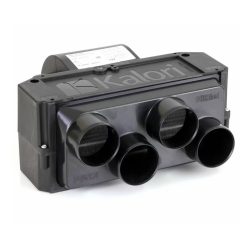Our Heater Boxes deliver compact, high-output cabin heating. A coolant-fed heat exchanger and multi-speed blower provide steady warmth and demisting on 12/24 V systems. Choose by heat output (kW), airflow (m³/h) and outlet configuration to match your ducting and available installation space.
Net price: 153 €
Net price: 123 €
Brief Summary & Key Benefits
Heater Boxes provide efficient auxiliary heating for passenger cars, off-road builds, race cars, vans and motorhomes. A coolant-fed core recovers engine heat while a powerful blower distributes warm air to the cabin or via duct outlets to demist the screen and warm footwells. Advantages include fast warm-up, compact packaging and straightforward integration with the OEM cooling circuit for reliable, controllable operation.
Technical Basics
Inside the unit, a finned heat exchanger connects to the vehicle’s coolant loop. A 12 V or 24 V fan forces air through the matrix, with typical airflow of 150–400 m³/h. Heat output commonly ranges from 2–6 kW, depending on coolant temperature and cabin size. Outlets are round spigots (Ø50/Ø60/Ø80 mm) that accept standard flex hose or rigid ducting to the windscreen, side vents or foot area.
Control options include two/three-speed switches or PWM control; on the water side a manual or electric shut-off valve refines temperature. Housings are impact-resistant plastic or metal, and the fan bearing design targets long life. Noise depends on wheel design and the ductwork; with proper routing the system runs quiet.
Compatibility: coolant connections are typically 16–19 mm hose with quality clamps. Electrical draw is around 3–15 A depending on speed, so use a fused supply and relay. Mounting uses multi-point brackets with vibration isolators.
Common pitfalls are poor air path (long/narrow ducts), trapped air in the water loop, undersized wiring and missing condensate routing—each can reduce output or cause leaks/noise.
Selection Criteria
Heat output (kW): match to cabin volume and insulation. Small cabins work with 3–4 kW; larger vans or motorhomes benefit from 4–6 kW.
Airflow (m³/h): higher flow improves demisting; frequent idling favours multi-outlet designs with balanced distribution.
Outlet size/count: select spigots to suit existing ducts (Ø50/Ø60/Ø80 mm). Multiple outlets enhance screen and footwell coverage.
System voltage: choose 12 V or 24 V to match the vehicle. Fleets often prefer 24 V for lower current at the same power.
Packaging: pick a location protected from heat and impact yet allowing good ventilation. Plan bracketry and duct routes in advance.
Controls: simple stepped control or PWM fan with optional water valve; consider adding an intake filter in dusty use.
Installation & Maintenance
Water loop: tee into the hot feed, return to the cold side, and add a bleed at the highest point to avoid air locks. Use quality clamps, avoid tight bends and secure hoses clear of moving parts. Electrical: size wiring correctly, add a fuse/relay and a solid ground.
Ducting: minimise length and bends; avoid restrictions. Use flat defroster vents for the windscreen. Mount the unit to a rigid base with vibration isolators. Provide a drain for any condensate.
Maintenance: blow dust from the fins, check connections each season and listen for bearing noise. Refresh coolant per OEM intervals; scale reduces heat transfer and performance.
FAQ
Q: Will it heat at idle?
A: Yes—the box uses engine heat; effectiveness depends on coolant temperature and airflow.
Q: Can I fit a 12 V unit to a 24 V vehicle?
A: No—always match voltage to avoid motor/electronics damage.
Q: Do I need a water valve?
A: Recommended for precise temperature control and to reduce summer heat soak.
Q: Which duct size should I choose?
A: Ø60 mm suits most cabins; longer runs or multiple branches may need larger diameter.
Q: What fuse rating is typical?
A: Usually 10–15 A, but always follow the manufacturer’s data for your specific unit.


